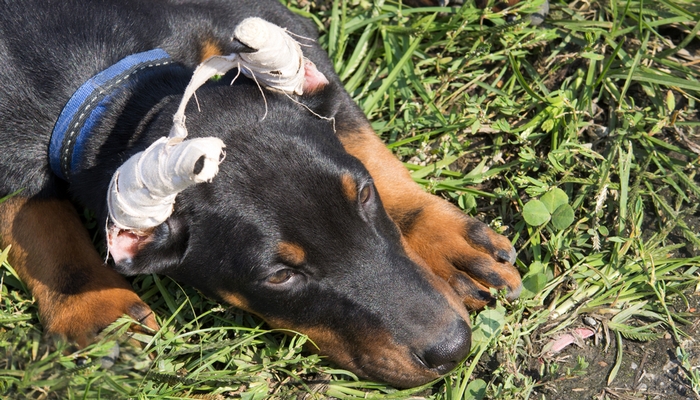
Table of Contents
With the excitement of bringing home a purebred puppy, many new owners are given the option they perhaps had never even thought of before — whether to subject their pet to ear cropping or tail docking.
Before you have any surgery performed on your dog, please consider the risks and trauma of cutting dogs' tails and ears first.
Think about whether the benefits outweigh the pain it would cause your puppy.
Ear cropping and tail docking were once popular surgeries amongst many breeds that have recently come under fire.
Although some state that both are necessary to prevent ear infections and potential injuries, others claim that there is no justification for the surgeries and that they amount to animal cruelty.
In fact, many countries have started to ban the practice of ear cropping and cutting dogs' tails, except in certain situations (such as certain working dogs or when a dog has a significant deformity or injury).
However, both are still unregulated in the United States, although some states have tried unsuccessfully to introduce legislation to ban it.
Although no official law prohibits these surgeries, many American dog associations have spoken against them and recommend that owners stop ear cropping and tail docking.
The American Veterinary Medical Association strongly opposes the surgeries and recommends that owners not perform them, stating that they pose unnecessary risks.
A Case Against Cutting Dogs Tails and Ears
There are also animal hospitals that now ban cutting dogs' tails and cropping their ears.
Banfield Pet Hospital, one of the largest hospital networks in the nation, no longer allows ear cropping or tail docking.
Although the American Kennel Club (AKC) does not officially oppose ear cropping or tail docking (they state that they are “integral to defining and preserving breed character”), they do state that neither is necessary to win competitions.
This is significant because many owners who choose to have the surgeries do so because they think they are necessary to be competitive dogs.
The History of Ear Cropping and Tail Docking
Both procedures have deep historical roots.
Many myths surrounding ear cropping and cutting dogs' tails have been circulating for hundreds, some even thousands, of years.
 Tail docking is an extremely old procedure, and its earliest records date back to the Roman era. It was considered necessary for those who owned hunting dogs but were not legally allowed to hunt (mostly members of the lower classes).
Tail docking is an extremely old procedure, and its earliest records date back to the Roman era. It was considered necessary for those who owned hunting dogs but were not legally allowed to hunt (mostly members of the lower classes).
The tail was considered necessary for a dog’s speed and agility, so when a dog was not allowed to hunt, the tail was removed.
Paradoxically, later hunting dogs’ tails would be removed for the exact opposite reason.
Historically, tails were also removed from working dogs to prevent injuries.
It was thought their tails might get caught or hit, and removing them while the dog was still young was best.
It was considered thoughtful since a young puppy would not remember the pain, while an older dog could suffer greatly from an injury.
 Ear cropping (PDF) is slightly more recent, but it has been performed for hundreds of years. It was initially performed on hunting and guard dogs. The ears were considered an easy target for wild animals, so they were removed from puppies.
Ear cropping (PDF) is slightly more recent, but it has been performed for hundreds of years. It was initially performed on hunting and guard dogs. The ears were considered an easy target for wild animals, so they were removed from puppies.
They thought that it would make a dog a fiercer opponent to wandering bears or wolves that might attack and be able to bring a dog down or seriously injure them by their ears.
They were also removed for the same reason as fighting dogs.
They thought that other dogs in the ring might be able to bring their dog down by their ears.
The earliest version of ear cropping was cruelly pulling the ears off puppies while they were still extremely young.
As time wore on, ear cropping and tail docking were performed for aesthetics. Most records of the surgeries in the past few hundred years refer to them as giving the dogs a more pleasing appearance.
By the 1950s, ear cropping and tail docking were extremely common amongst certain breeds, but by the 1970s, there started a growing concern about the procedures. Since then, they have grown increasingly unpopular.
RELATED: Preventing Over-Vaccination in Dogs
How Tail-Docking and Ear Cropping are Performed
The first procedure a purebred dog will undergo is tail docking.
It is typically performed on a puppy during the first few days of life (under 10 to 14 days of age).
Although it is an extremely painful procedure, no anesthesia is given to the puppies because they will not remember it.
However, research has shown it to be traumatizing on the puppy’s nerves, causing the dog to process pain differently, even without the memories.
Tail docking is not always necessarily performed by veterinarians in a sterile setting. It is sometimes performed by breeders, especially at infamous puppy mills.
Since they are only concerned about making a profit, the puppy is given nothing to ease the traumatizing pain and risks infection by the lack of a sterilized setting.
Ear cropping, also known in veterinary circles as “cosmetic otoplasty,” is performed on puppies between 7 and 12 weeks.
It is significantly more painful for dogs after the age of 16 weeks, and the dog is more likely to remember it.
Up to two-thirds of the ear is removed in the procedure, and then the open wound is stitched close.
 From there, the dog’s ears are taped up to train them how to stand up straight in the right shape. Dogs are put under anesthesia procedure, but the post-operative pain is still typically significant for the young puppies.
From there, the dog’s ears are taped up to train them how to stand up straight in the right shape. Dogs are put under anesthesia procedure, but the post-operative pain is still typically significant for the young puppies.
Ear cropping and tail docking are not taught in veterinary school and veterinarians are required to learn on the job.
Typically, they learn from more experienced vets, but without an official course to teach them, there is no streamlined process for tail docking or ear cropping.
Also, like tail docking, ear cropping is sometimes performed by breeders instead of licensed veterinarians. In an attempt to save money, many dogs have been mutilated beyond repair by an amateur.
There are also issues with ear cropping, not “taking.”
Despite being performed by a trained veterinarian, the ears may not stand for a variety of reasons.
Owners sometimes find themselves with a puppy with mutilated ears and a large vet bill for a procedure that did not work.
In fact, some veterinarians will not perform ear cropping because they do not want to be held liable if a dog’s ears do not stand up.
RECOMMENDED: The Truth – Is Anesthesia Safe for Dogs?
Why You Should Rethink Ear Clipping and Tail Docking
 There is a reason that the practice is banned in 36 countries: it is a cruel practice that is only meant to enhance a dog’s aesthetics.
There is a reason that the practice is banned in 36 countries: it is a cruel practice that is only meant to enhance a dog’s aesthetics.
As of 2022, there are also 21 US states that regulate tail docking in some form.
Although there are various reasons that certain proponents of the procedures give to explain why they are necessary, there is no concrete evidence that either ear clipping or tail docking should be performed routinely on any breed.
The first reason some defend ear clipping is that it helps prevent ear infections in dogs.
However, it is important to note that the two breeds most prone to ear infections, cocker spaniels and poodles, do not have their ears cut.
No research backs up the claim that it prevents ear infections, and 80% of dogs will never get ear infections in the first place.
Likewise, most owners electively choose to have their dog’s tail docked because they want to avoid injury to the tail.
Most modern dogs, though, are not out working like in times past when they might injure their tail.
It is also more likely that cutting off their tail will cause more dog injuries.
Tails provide stability for dogs and cutting off their natural balance will probably cause a do to be clumsier, adding to injury.
Also, there are plenty of working dogs that are not traditionally docked.
Spaniels and Retrievers, for example, are often working dogs.
They are out hunting and at risk for injury, but historically, they have never had their tails docked.
Even with their widespread lack of docking, tail injuries amongst these breeds are rare.
Based on tail injuries amongst these breeds, it would seem that docking causes other breeds far more pain than the slight risk of injuring their tail.
Obvious Risks to Cutting Dogs Tails and Ears
 Besides the arguments for surgically altering a dog’s appearance electively lacking any substantial concrete evidence and even being somewhat counter-intuitive, there are also clear drawbacks and risks in surgery for your dog.
Besides the arguments for surgically altering a dog’s appearance electively lacking any substantial concrete evidence and even being somewhat counter-intuitive, there are also clear drawbacks and risks in surgery for your dog.
The first obvious risk is the procedure itself. There is a risk of infection in any surgery.
Especially if a licensed veterinarian does not perform it, a dog could become sick or worse from a surgical infection.
Another risk of cutting dogs' tails is nerve damage.
Although a young pup may not remember the surgery, its brain is still making pathways and trying to understand the environment.
By creating such a traumatizing experience, it can likely cause permanent damage both physically and emotionally.
Yet another risk in tail docking is the amount of emotion dogs display through their tails.
If a dog cannot show emotions (such as excitement, submission, fear, or anger), there is some evidence that the dog will become more aggressive.
Being able to show emotion through their tail is an instinctual quality in a dog, and the inability to express themselves will lead to negative behaviors.
Likewise, dogs also show their emotion through their ears. Whether submissive, scared, or happy, dogs move their ears around to convey emotion.
Just like having a docked tail, being unable to show emotion will likely make a dog more aggressive.
Also, cutting dogs' tails can lead to tumors.
The tumor that can develop in a docked tail called a neuroma, is a nerve tumor.
It can become extremely sensitive, and a dog can snap if it is touched.
The result of a traumatic injury, neuroma is a preventable tumor that will cause your dog even more unnecessary pain.
SIMILAR: Skin Tags On Dogs – 8 Ways To Prevent & Treat Them
Ear Cropping and Tail Docking: Outdated Procedures
Ear cropping and tail docking have become increasingly unpopular amongst modern dog owners.
Most would not want to put their dog through such needless pain and spend money on surgery just for aesthetics.
As a result, the surgeries are no longer fashionable amongst dog owners.
The main group that still regularly utilizes the surgeries are competition dogs.
Although the American Kennel Club states that ear cropping and cutting dogs' ears are not necessary for competition, it nevertheless states in the scoring guide to heavily penalize all dogs who are not cropped or docked if their breed traditionally is.
In order to put the practice behind for good, the AKC needs to change its scoring and start banning surgically altered dogs from shows.
This is a common practice in Britain, where dogs of a certain age are no longer allowed to compete.
The act of cutting dogs' tails and ears is outdated, unnecessary, and traumatizing.
It has no place in modern society, and the sooner that it is banned, the better off American dogs will be.
READ NEXT: 20 Best Dog Books On Canine Health and Care















